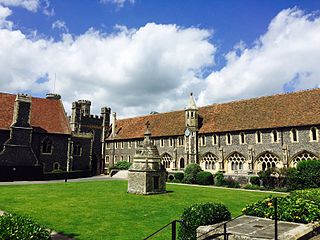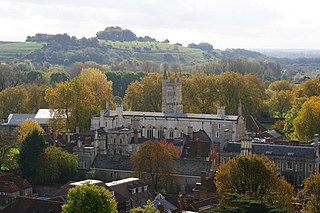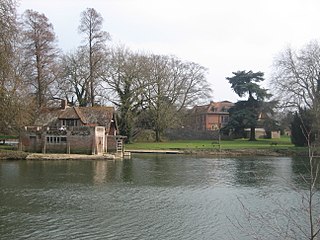
The King's School is a public school in Canterbury, Kent, England. It is a member of the Headmasters' and Headmistresses' Conference and the Eton Group. It is Britain's oldest public school; and is arguably the oldest continuously operating school in the world, since education on the Abbey and Cathedral grounds has been uninterrupted since AD 597.

Winchester College is a public school with some provision for day pupils, in Winchester, Hampshire, England. It was founded by William of Wykeham in 1382 as a feeder school for New College, Oxford, and has existed in its present location ever since. It is the oldest of the nine schools considered by the Clarendon Commission. The school has begun a transition to become co-educational, and has accepted male and female day pupils from September 2022, having previously been a boys' boarding school for over 600 years.

Clifton College is a public school in the city of Bristol in South West England, founded in 1862 and offering both boarding and day school for pupils aged 13–18. In its early years, unlike most contemporary public schools, it emphasised science rather than classics in the curriculum, and was less concerned with social elitism, e.g. by admitting day-boys on equal terms and providing a dedicated boarding house for Jewish boys, called Polack's House. Having linked its General Studies classes with Badminton School, it admitted girls to every year group in 1987 and was the first of the traditional, boys, public schools to become fully coeducational. Polack's House closed in 2005 but a scholarship fund open to Jewish candidates still exists. Clifton College is one of the original 26 English public schools as defined by the Public Schools Yearbook of 1889.

Immanuel Jakobovits, Baron Jakobovits was the Chief Rabbi of the United Hebrew Congregations of the Commonwealth from 1967 to 1991. Prior to this, he had served as Chief Rabbi of Ireland and as rabbi of the Fifth Avenue Synagogue in New York City. In addition to his official duties he was regarded as an authority in medical ethics from a Jewish standpoint. He was knighted in 1981 and became the first Chief Rabbi to enter the House of Lords in 1988 as Baron Jakobovits.

Bradfield College, formally St Andrew's College, Bradfield, is a public school for pupils aged 13–18, located in the small village of Bradfield in the English county of Berkshire. It is noted for its open-air Greek theatre and its triennial Greek Play.

Moses Rosen was Chief Rabbi of Romanian Jewry between 1948–1994 and president of the Federation of Jewish Communities of Romania between 1964 and 1994. He led the community through the entire Communist era in Romania and continued in that role after the restoration of democracy following the Romanian Revolution of 1989. In 1957, he became a deputy in the Romanian parliament, a position he held through the Communist regime, and after 1989, in the democratic parliament. In the 1980s, the Romanian authorities allowed him to receive Israeli nationality and he was elected president of the Council of the Jewish Diaspora Museum in Tel Aviv.

Pápa is a historical town in Veszprém county, Hungary, located close to the northern edge of the Bakony Hills, and noted for its baroque architecture. With its 32,473 inhabitants (2011), it is the cultural, economic and tourism centre of the region.

Glenhazel is a suburb of the Municipality of Johannesburg, South Africa. It is located in Region E, bordering Fairmount, Sandringham, Lyndhurst and Percelia Estate. The area lies on a sloping hill with a park in the valley. It is known for its large Jewish population as well as for being home to the largest Jewish kosher hub in Johannesburg, which attracts many Jewish tourists.
Rabbi Dr Yaacov Kopul Rosen (1913–1962) was an anglo-Jewish rabbi and educationalist who, in 1946, testified before the Anglo-American Commission of Inquiry on Palestine, asking them not to "play politics with the remnants of the Jewish people." A book titled Memories of Kopul Rosen was published in 1970.
Houda Ezra Ebrahim Nonoo served as the Bahraini Ambassador to the United States from 2008 to 2013. She was appointed to the position by decree of Foreign Affairs Minister Khaled Ben Ahmad Al-Khalifa. Nonoo is the first Jew, and third woman, to be appointed ambassador of Bahrain. She is also the first Jewish ambassador of any Middle Eastern Arab country, and the first female Bahraini ambassador to the United States.

Bahraini Jews constitute one of the world's smallest Jewish communities, although its origins go back to late antiquity. Talmudic sources refer to ports and islands on the Persian Gulf, indicating that Jews may have already settled in this region. Arabic sources record Jews in the old capital of Bahrain, Hajar, at the time of the Islamic conquest in 630 C.E. In the 12th century, the Jewish traveler-adventurer Benjamin of Tudela mentions 500 Jews living in Qays, and 5,000 in Al-Qatîf, involved in pearl fishery. In the 19th century, there were Jewish merchants from Iraq, Persia, and India in Bahrain.

The Mir Yeshiva, commonly known as the Mirrer Yeshiva or The Mir, was a Lithuanian yeshiva located in the town of Mir, Russian Empire. After relocating a number of times during World War II, it has evolved into three yeshivas: one in Jerusalem and two in Brooklyn, New York: the Mir Yeshiva, and Bais Hatalmud.

Mongewell is a village in the civil parish of Crowmarsh, about 1 mile (1.6 km) south of Wallingford in Oxfordshire. Mongewell is on the east bank of the Thames, linked with the west bank at Winterbrook by Winterbrook Bridge. The earthwork Grim's Ditch, now part of The Ridgeway long-distance footpath, passes through the northern part of it and is a scheduled ancient monument.
Jeremy Rosen is an Orthodox rabbi, author, and lecturer. Rosen is an advocate of modern Orthodox Judaism which aims to balance tolerance of modernity, individual variations and a commitment to Jewish law (Halacha). His articles and weekly column appear in publications in several countries, including the Jewish Telegraph and the London Jewish News, and often comments on religious issues on the BBC. He is director of Yakar Educational Foundation in London, and chairman of the Faculty for Comparative Religion (FVG) in Antwerp.
Michael "Mickey" Rosen was a British-born Israeli rabbi and founder of Yakar, an innovative Jewish learning community and synagogue.
Ottershaw School was founded in 1948 as an English school for boys in Ottershaw Park, Ottershaw, approximately 30 miles (48 km) southwest of London between Chertsey and Woking, Surrey, south of England, on an estate that dated back to 1761, when the first house was built there.
Jews have been living in Maine, a state in the northeastern United States, for 200 years, with significant Jewish communities in Bangor as early as the 1840s and in Portland since the 1880s. The arrival of Susman Abrams in 1785 was followed by a history of immigration and settlement that parallels the history of Jewish immigration to the United States.
The Federation of Synagogues is a British Jewish organisation with headquarters in Hendon, London. It comprises a network of 19 constituent and seven affiliated communities.
Ernest (Kopul) Krausz was an Israeli professor of sociology who served as rector and Acting President of Bar Ilan University. He also taught at Netanya Academic College.













